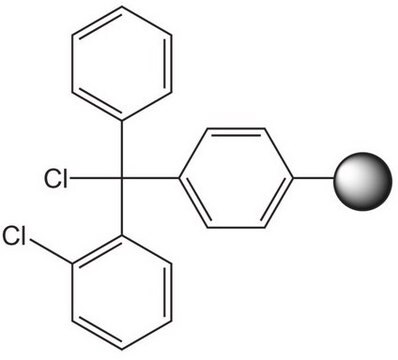8.55015
Amino PEGA resin
Novabiochem®
Sinônimo(s):
Amino PEGA resin
About This Item
Produtos recomendados
Nível de qualidade
linha de produto
Novabiochem®
PEGA
forma
beads
adequação da reação
reaction type: Fmoc solid-phase peptide synthesis
fabricante/nome comercial
Novabiochem®
aplicação(ões)
peptide synthesis
grupo funcional
amine
temperatura de armazenamento
2-8°C
Descrição geral
Associated Protocols and Technical Articles
Protocols for Loading of Peptide Synthesis Resins Literature references
Literature references
[1] M. Meldal, et al. (1992) Tetrahedron Lett., 33, 3077.
[2] F. I. Auzanneau, et al. (1994) J. Peptide Sci., 1, 31.
[3] M. Meldal in ′Peptides 1992, Proc. 22nd European Peptide Symposium′, C. H. Schneider & A. N. Eberle (Eds), ESCOM, Leiden, 1993, pp.61.
[4] M. Meldal, et al. in ′Innovation & Perspectives in Solid Phase Synthesis, 3rd International Symposium′, R. Epton (Eds), Mayflower Worldwide, Birmingham, 1994, pp. 259.
[5] M. Meldal, et al. (1993) Int. J. Peptide Protein Res., 41, 250.
[6] M. Meldal, et al. (1994) J. Chem. Soc., Chem. Commun., 849.
[7] M. Meldal, et al. (1994) Proc. Natl. Acad. Sci. USA, 91, 3314.
[8] M. Renil, et al. (1998) J. Peptide Sci., 4, 195.
[9] J. C. Spetzler, et al. (1998) J. Peptide Sci., 4,128.
[10] M. Meldal, et al. (1998) J. Peptide Sci., 4 ,83.
[11] J. A. Camarero, et al. (1998) J. Peptide Res., 51, 303.
[12] J. A. Camarero, et al. (2000) Lett. Pept. Sci., 7,17.
[13] O. Melnyk, et al. (2001) J. Org. Chem., 66, 4153.
[14] J. Buchardt, et al. (2000) J. Comb. Chem., 2, 624.
[15] J. F. Tolberg, et al. (2002) J. Org. Chem., 67, 4143.
[16] J. Bondebjerg, et al. (2002) J. Am. Chem. Soc., 124, 11046.
[17] J. Tulla-Puche, et al. (2004) J. Org. Chem., 69, 4101.
[18] S. Aggarwal, et al. (2005) Biomaterials, 26, 6077.
Aplicação
- Fluorescence-Based On-Resin Detection of Three Model Proteases: Discusses the use of Amino PEGA resin modified with backbone amide linker (BAL) for developing solid support-bound probes used in fluorescence-based assays. (Milicevic & Hlavác, 2021).
- Attachment of cyclodextrin acids to PEGA resin and study of binding with fluorescence microscopy: Investigates the attachment of cyclodextrin to amino PEGA resin and evaluates their binding interactions using fluorescence microscopy. (Langhorn et al., 2021).
Ligação
Nota de análise
Appearance of substance (visual): beads
Loading (determined from the substitution of the Fmoc-Leu loaded resin): 0.30 - 0.50 mmol/g
Swelling Volume (in DMF): lot specific result
Swelling Volume (in water): lot specific result
dry resin %: lot specific result
The resin is sold swollen in ethanol. 50 - 100 mesh
Informações legais
Código de classe de armazenamento
11 - Combustible Solids
Classe de risco de água (WGK)
nwg
Ponto de fulgor (°F)
Not applicable
Ponto de fulgor (°C)
Not applicable
Certificados de análise (COA)
Busque Certificados de análise (COA) digitando o Número do Lote do produto. Os números de lote e remessa podem ser encontrados no rótulo de um produto após a palavra “Lot” ou “Batch”.
Já possui este produto?
Encontre a documentação dos produtos que você adquiriu recentemente na biblioteca de documentos.
Conteúdo relacionado
The Novabiochem® product line has one of the most extensive ranges of polymer-supports for solid phase peptide synthesis. They range from high-loaded, lows welling for the large-scale production of relatively short peptides to high-swelling, low-loaded for the synthesis of long or difficult sequences.
Nossa equipe de cientistas tem experiência em todas as áreas de pesquisa, incluindo Life Sciences, ciência de materiais, síntese química, cromatografia, química analítica e muitas outras.
Entre em contato com a assistência técnica